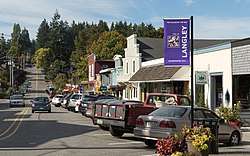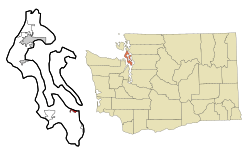Langley, Washington
Langley is a city in Island County, Washington, United States which is located near the south end of Whidbey Island, overlooking the Saratoga Passage. It is the third largest incorporated area on Whidbey. The population was 1,035 at the 2010 census, while the ZCTA for Langley's post office had a population of 4,878.[2] The geographical area of the city is only 0.8 square miles (2.1 km2) but the ZCTA includes 26.20 square miles (67.9 km2).[2]
Langley | |
|---|---|
 Main Street in Langley | |
 Seal | |
| Nickname(s): "The Village by the Sea" | |
 Location of Langley in Washington | |
| Coordinates: 48°2′12.92″N 122°24′30.6″W | |
| Country | United States |
| State | Washington |
| County | Island |
| Incorporated | February 26, 1913 |
| Government | |
| • Type | Mayor-council government with 5 Council Members |
| • Mayor | Tim Callison |
| Area | |
| • City | 1.58 sq mi (4.09 km2) |
| • Land | 1.01 sq mi (2.61 km2) |
| • Water | 0.57 sq mi (1.48 km2) |
| • Metro | 26.2 sq mi (67.86 km2) |
| Elevation | 0–90 ft (0–27.7 m) |
| Population | |
| • City | 1,035 |
| • Estimate (2018)[3] | 1,136 |
| • Density | 1,126.98/sq mi (435.14/km2) |
| • Metro | 4,878 |
| Time zone | UTC-8 (PST) |
| • Summer (DST) | UTC-7 (PDT) |
| ZIP code | 98260 |
| Area code(s) | 360 564 |
| Telephone exchanges | 221, 321, 331, 341, 730 |
| FIPS code | 53-38355[4] |
| GNIS feature ID | 1512376[5] |
| Annual budget | 2012, approximately $5.5 million |
| Website | City of Langley |
Langley is served by South Whidbey Fire/EMS, the Langley Police Department, and is the home of South Whidbey School District #206. The current mayor is Tim Callison.
History
Langley was founded in the 1800s by Jacob Anthes,[6] and was named for J.W. Langley of Seattle.[7] In 1902, Mr. Anthes built a logger bunkhouse that is still standing in the downtown core and currently serves as a museum. Langley was officially incorporated on February 26, 1913.
At one point in the late 1900s, a number of 4H rabbits escaped their enclosures at the Island County Fair and went on to become a large and successful feral population living, initially, around the county fairgrounds and, subsequently, extensively around Langley and south Whidbey Island. The rabbits later became a controversial topic in Langley politics in the 2010s with citizens and groups advocating for public policy positions from removal and relocation, to eradication, to control with raptors while others advocate for a more lenient position of community acceptance.[8][9][10][11]
Government and politics
The City of Langley operates under a mayor–council form of government. The mayor and city councilmembers are elected to four-year terms. The City Council enacts ordinances and resolutions, holds public hearings, receives citizen comments, authorizes payment of City funds, approves contracts, and creates committees and boards to assist in the operation of city government. The City Council meets on the first and third Monday of each month in City Hall at 5:30pm. The Mayor presides over Council meetings and is responsible for the administration of City government.
The current mayor is Tim Callison, elected in 2015 with 52.9% of the vote.[12] He was re-elected in 2019.[13][14]
Events
Mystery Weekend is a yearly mystery game event occurring the last weekend in February. A fake newspaper story is run in the South Whidbey Record or a fake newspaper can be purchased from the Visitor & Information Center, detailing the persons involved and instructing players to seek out characters played by local residents.[15]
The Welcome the Whales Festival and parade is held at the beginning of April each year.
The Djangofest NW Music Festival is held in September each year. This five-day festival celebrates the gypsy jazz style of Django Reinhardt, and features workshops, concerts, and impromptu jam sessions around town.
The Whidbey Island Area Fair is held in July at the Island County Fairgrounds in Langley. The original Island County Fair Association was formed in 1912, predating the incorporation of Langley itself.[16]
Geography
Langley is located at 48°2′13″N 122°24′31″W (48.036922, -122.408500).[17]
According to the United States Census Bureau, the city has a total area of 1.08 square miles (2.80 km2), all of it land.[18]
Demographics
| Historical population | |||
|---|---|---|---|
| Census | Pop. | %± | |
| 1920 | 274 | — | |
| 1930 | 268 | −2.2% | |
| 1940 | 338 | 26.1% | |
| 1950 | 427 | 26.3% | |
| 1960 | 448 | 4.9% | |
| 1970 | 547 | 22.1% | |
| 1980 | 650 | 18.8% | |
| 1990 | 845 | 30.0% | |
| 2000 | 959 | 13.5% | |
| 2010 | 1,035 | 7.9% | |
| Est. 2018 | 1,136 | [3] | 9.8% |
| U.S. Decennial Census[19] | |||
2010 census
As of the census[2] of 2010, there were 1,035 people, 555 households, and 271 families residing in the city. The population density was 958.3 inhabitants per square mile (370.0/km2). There were 678 housing units at an average density of 627.8 per square mile (242.4/km2). The racial makeup of the city was 94.1% White, 0.1% African American, 0.6% Native American, 1.6% Asian, 0.1% Pacific Islander, 0.7% from other races, and 2.8% from two or more races. Hispanic or Latino of any race were 3.2% of the population.
There were 555 households of which 16.6% had children under the age of 18 living with them, 39.1% were married couples living together, 7.6% had a female householder with no husband present, 2.2% had a male householder with no wife present, and 51.2% were non-families. 43.6% of all households were made up of individuals and 23.6% had someone living alone who was 65 years of age or older. The average household size was 1.86 and the average family size was 2.51.
The median age in the city was 57 years. 14% of residents were under the age of 18; 3.4% were between the ages of 18 and 24; 14.4% were from 25 to 44; 39.8% were from 45 to 64; and 28.4% were 65 years of age or older. The gender makeup of the city was 40.9% male and 59.1% female.
2000 census
As of the 2000 census,[4] there were 959 people, 486 households, and 268 families residing in the city. The population density was 1,165.9 people per square mile (451.6/km²). There were 542 housing units at an average density of 658.9 per square mile (255.2/km²). The racial makeup of the city was 96.25% White, 0.31% African American, 0.42% Native American, 0.52% Asian, 0.42% from other races, and 2.09% from two or more races. Hispanic or Latino of any race were 1.88% of the population.
There were 486 households, out of which 24.3% included children under the age of 18, 40.9% were married couples living together, 12.1% had a female householder with no husband present, and 44.7% were non-families. 39.9% of all households were made up of individuals and 21.2% had someone living alone who was 65 years of age or older. The average household size was 1.97 and the average family size was 2.61.
Langley's population was spread out with 19.7% under the age of 18, 5.8% from 18 to 24, 15.7% from 25 to 44, 35.5% from 45 to 64, and 23.3% who were 65 years of age or older. The median age was 49 years. For every 100 females, there were 76.9 males. For every 100 females age 18 and over, there were 72.3 males.
The median income for a household in the city was $34,792, and the median income for a family was $51,563. Males had a median income of $41,750 versus $30,125 for females. The per capita income for the city was $24,940. About 5.2% of families and 10.6% of the population were below the poverty line, including 10.7% of those under age 18 and 6.6% of those age 65 or over.
References
- "2018 U.S. Gazetteer Files". United States Census Bureau. Retrieved February 16, 2020.
- "U.S. Census website". United States Census Bureau. Retrieved December 19, 2012.
- "Population and Housing Unit Estimates". United States Census Bureau. June 27, 2019. Retrieved February 16, 2020.
- "U.S. Census website". United States Census Bureau. Retrieved January 31, 2008.
- "Langley". Geographic Names Information System. United States Geological Survey.
- "27 Things to Do (On Whidbey Island)" (PDF). MacGregor's 2006-2007 Whidbey Island Newcomers' & Visitors' Guide. 2005–2006. Retrieved August 4, 2006.
- Meany, Edmond S. (1923). Origin of Washington geographic names. Seattle: University of Washington Press. p. 142.
- https://www.nbcnews.com/news/us-news/hundreds-bunnies-plague-langley-washington-n429186
- https://www.seattletimes.com/seattle-news/northwest/its-not-cute-anymore-bunny-brouhaha-as-langley-is-overrun-with-rabbits/
- Rabbits raid Langley City Hall garden, but overall population appears to be on the decline, South Whidbey Record, April 4, 2017, accessed September 13, 2019.
- Langley’s rabbit discussion returns; Port weighs options, South Whidbey Record, January 13, 2018, accessed September 13, 2019.
- "Island County Elections Results".
- Guthrie, Patricia (April 19, 2019). "Callison to seek second term as Langley mayor". South Whidbey Record. Retrieved December 12, 2019.
- "November 5, 2019 General Election Results". Washington Secretary of State. November 26, 2019. Retrieved December 12, 2019.
- "Mystery Weekend 2018". Retrieved August 18, 2017.
- http://fair.whidbeyislandfair.com/home/history Whidbey Island Area Fair
- "US Gazetteer files: 2010, 2000, and 1990". United States Census Bureau. February 12, 2011. Retrieved April 23, 2011.
- "US Gazetteer files 2010". United States Census Bureau. Archived from the original on July 2, 2012. Retrieved December 19, 2012.
- United States Census Bureau. "Census of Population and Housing". Retrieved August 31, 2014.
